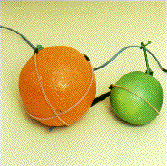 "The Rubbery Ruler"
"The Rubbery Ruler" 
An elegant, economical answer to the requirements of displacement
measurement
Developed by The School of Physics, The University of Melbourne
 The Rubbery Ruler is a wide range, conformable, capacitive displacement
transducer.
In its basic form the Rubbery Ruler consists of a bifilar helix of
insulated conductive wires embedded in a tube of elastomeric material
(Fig. 1).
The Rubbery Ruler is a wide range, conformable, capacitive displacement
transducer.
In its basic form the Rubbery Ruler consists of a bifilar helix of
insulated conductive wires embedded in a tube of elastomeric material
(Fig. 1).

This combination results in an extraordinary long range of elongation.
The range can be more than double its initial length.
The flexibility permitted by the design allows the transducer to
conform to the contour of objects to which it is attached
(e.g. chest, joint, heart, fruit, mechanical structure) whilst
monitoring accurately their dimensional changes (Fig. 2).

The transducer is basically a spring -- elongation and
compliance are determined by the elastic properties of the
elastomeric covering and the double helix core
dimensions.
The Rubbery Ruler is fully selaed and can be operated in harsh
environmental conditions.
Electrically the Rubbery Ruler can be described as a distributed
capacitor.
The two wires of the double helix core constitute the electrodes
of a variable gap capacitor.
As the Rubbery Ruler is stretched, the two wires of the core separate
in a uniform, reversible fashion controlled by the elastomeric
covering.
Standard or propietary
signal processing techniques are used to convert capacitance changes
into a frequency or current or voltage proportional to elongation.
Rubbery Rulers can be made in just about any shape and size,
depending on the desired application.
Elongation can be up to 250% with an accuracy of 0.1%.

The European Space Agency is using
Rubbery Rulers in the Analog
Biomedical Recorder Space Suit to provide a database of human
movements in space.


Specific applications of Rubbery Ruler technology
Biomedical and health care
The Rubbery Ruler can be easily configured to
monitor flexions, joint movements and expansion and contraction
of body parts.
Unlike the more expensive inductive transducers, they are
insensitive to electro-magnetic interference and require simple
conditioning electronics.
Some specific applications are:
- Monitors for breathing, plethismography, joint movements
- Miniature sensors for "in vivo" applications
- Monitors and alarms (e.g. backbone injury prevention)
- Kinesiology
- Nocturnal penile tumescence monitors for impotence clinics
(as a replacement for mercury transducers)
Robotics
- Input transducers for remote manipulators and for "virtual
reality" environments and games
Silviculture
Rubbery Rulers are used as dendrometers in orchards and forests
Geomechanics
- Monitoring the movements of foundations
- Monitoring movements in mining operations
- Monitoring the movements of ground faults
Aerospace
Rubbery Rulers have an electrically balanced structure with inherently
little electro-magnetic leakage.
They can be constructed with a high capacitance per unit length, have
high noise immunity and very high sensitivity.
They are of very low weight.
Engineering
Rubbery Rulers are conformable (in fact they can be wrapped around
objects), self-aligning and are insensitive to vibration.
They are sealed and the elastomer (silicone, flurosilicone, etc.)
can be selected to be impervious to corrosive fluids.
Rubbery Rulers are being used successfully in an aluminium smelting
plant to servo position the carbon electrodes in electrolytic cells.
They can operate in the presence of very large DC magnetic fields,
in a highly corrosive atmosphere and in high temperatures.
Other applications include:
- Structural deformation analysis
- Servo control of tunnel boring machines
- Rolling mull gap monitors
- Feedback elements for actuators
- Transducers for weighing, general metrology, fatigue testing, etc.
Summary of properties
Click here for a summary of
properties of the Rubbery Ruler.
For more information
Click here for contact information.

 Rubbery Ruler Home Page
Rubbery Ruler Home Page
 School of Physics Inventions Home Page
School of Physics Inventions Home Page
 School of Physics Home Page
School of Physics Home Page
 "The Rubbery Ruler"
"The Rubbery Ruler" 





![]() School of Physics Inventions Home Page
School of Physics Inventions Home Page